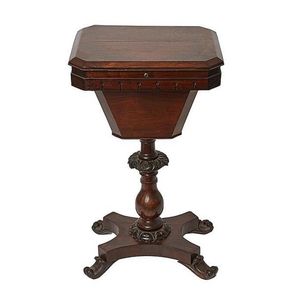Victorian Mahogany Sewing Table with Carved Pedestal
You must be a subscriber, and be logged in to view price and dealer details.
Subscribe Now to view actual auction price for this item
When you subscribe, you have the option of setting the currency in which to display prices to $Au, $US, $NZ or Stg.
- Victorian Period - The Victorian period of furniture and decorative arts design covers the reign of Queen Victoria from 1837 to 1901. There was not one dominant style of furniture in the Victorian period. Designers used and modified many historical styles such as Gothic, Tudor, Elizabethan, English Rococo, Neoclassical and others, although use of some styles, such as English Rococo and Gothic tended to dominate the furniture manufacture of the period.
The Victorian period was preceded by the Regency and William IV periods, and followed by the Edwardian period, named for Edward VII (1841 ? 1910) who was King of the United Kingdom and the British Dominions and Emperor of India for the brief period from 1901 until his death in 1910. - Platform Base - Flat-surfaced bases supporting the pedestals of dining tables and some other smaller occasional tables, including console and pier tables. Introduced during the Regency period, they continued in popularity throughout the 19th century. On tables, platform bases are usually of triform, or three-cornered shape, supported by bun, turned or carved claw feet. They may be either of veneered box-like construction, or formed from the solid timber.
- Mahogany - Mahogany is a dense, close grained red-coloured timber from the West Indies and Central America. It was first imported into Europe in the the early 18th century and its use continued through the 19th century. It was popular for furniture making because of its strength, the wide boards available, the distinctive grain on some boards, termed flame mahogany and the rich warm colour of the timber when it was polished.. The "flame" was produced where a limb grew out from the trunk of the tree, and this timber was usually sliced into veneers for feature panels on doors, backs and cornices.
Some terms used to describe mahogany relate to the country from which it originally came, such as "Cuban" mahogany, "Honduras" mahogany etc. However unless the wood has been tested the names assigned are more a selling feature, rather than a true indication of the timber's origin.
This item has been included into following indexes:
- tables, purpose or type
Visually similar items

A Regency mahogany fold-over top card table, 19th century, with square tapered central column, lion paw feet and green felt top. Height 74 cm; top 86 x 85 cm

A Regency style mahogany occasional table, the rectangular top raised on an octagonal tapering column issuing from a carved knop and quatrefoil plinth base with squat bun feet. 72 cm x 42 cm x 64 cm.

A Victorian mahogany work table c.1880 and later. The table has a lift up top with interior compartments, and hollow pedestal column, used for needlework storage. Height 73 cm; top: 43 x 43 cm

Victorian flame veneered mahogany fold-over card table on heavy baluster column and four scroll legs
